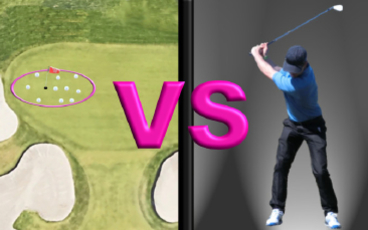I personally believe that skill development is going to be the next “big thing” in golf. It’s one of the most powerful ways to improve your golf game, and very few players/instructors (currently) are using it as an intervention.
Luckily for you, this is my niche area.
Why Is This Important To Know?
Have you ever tried to make your swing better, only to make your golf worse?
Skill development approaches are not only very different to training your technique, but they can actually be in opposition.
For example, an overly technical approach to training can actually harm your skill-level, for many reasons. I see this every day with golfers who are trying to improve their swings and are not getting better (or even going backwards).
For these reasons, it is important to understand the differences so you better understand how to to train each one effectively.
Skill Defined
One of the most difficult things I have ever had to appropriately convey in a single sentence is a definition of what “skill” is. But, here goes.
Skill is the ability to make the reality/outcome as desired
For example, your
- Ability to hit a fairway
- Ability to control strike
- Ability to curve the ball
- Ability to control speed
Are all examples of skills.
The “outcome” part of the definition doesn’t have to be the shot result itself (e.g. controlling direction), but it can also be a part of what creates the result (e.g. controlling clubface direction).
 A player who can hit all 3 of the spots intentionally above is demonstrating high skill – even if only one of the spots (the middle) is good technique.
A player who can hit all 3 of the spots intentionally above is demonstrating high skill – even if only one of the spots (the middle) is good technique.
Technique Defined
Under my own philosophy, technique is defined as the method employed – or “what happened” technically.
For example, two players could hit fairways with a 75% consistency using very different techniques. One could say they are both as skilled as one another, even though their methods employed (swings) look different.
Technique could include;
- How much shoulder turn a player has
- How much weight shift they have
- Whether they have a steeper or flatter left arm position at the top of the swing
- Where they strike on the clubface
- Where they contact the ground
- Whether their swing path is left/right or more neutral
Or a million other similar things. Technique is the dominant topic of conversation when discussing improving your game.
In fact, I would hazard a guess that more than 99% of all instructional topics in magazines, on TV or in books solely look at technique.
But Aren’t They The Same Thing?
No.
To highlight this, let’s look at a few examples.
Same Skill, Different Technique
Dustin Johnson and Tiger Woods both hit a shot to 5ft from their target. Their skill of hitting their target was the same, but their techniques are incredibly different.
Poor technique, Good skill
Watch the short video below of Rory hitting a topped shot.
This was actually a trick shot by Rory – he intended to do it.
His ability to control the height the club came in through impact (arc height) to less than 1mm accuracy demonstrates incredible skill. However, the technique was ultimately poor (topping the ball is not a good technique).
Same Technique, Different Skill
Players A and B both shank a shot – demonstrating poor face-strike technique.
However, player A has the skill to be able to move the strike around the face at will – player B does not. Therefore player A will be able to use this skill to produce a better technique (face strike) on the subsequent shots.
They Have Cross-Overs
Technique and skill are different entities – but this is not to say they don’t feed into one another
For example, a better technique can definitely make it easier to demonstrate certain skills – it might be easier to strike the ground in a consistent location if your head isn’t moving around in wildly inefficient ways.
Also, a high skill level can help you create a better technique – it’s much easier to strike the sweet spot if you possess the ability (skill) of being able to move the strike from toe to heel at will – like me and my players.
But, once again, skill and technique are not to be confused. Where you strike the ground/face (your technique) is not the same thing as your ability to control where you strike the ground/face (your skill).
Why Is Skill Important?
Skill has so many advantages – and if you are not using skill-based learning approaches (like differential and variability practice, as well as transfer training) you are missing out on improving a big part of what makes a great player great.
Or, are you like every other golfer out there, only working on your swing technique?
Skill helps a golfer to;
- Calibrate a better technique
- Quickly fix issues that inevitably pop up (like a random shank appearing)
- Get better results out of their existing technique
- Still hit the ball well when making a swing change
- Adapt to the varying demands of a golf course(slope/lie etc).
How To Improve Your Skill
Now, I know that this title is Skill Vs Technique – but in your game it shouldn’t be either/or. You should be working on both to maximize your potential.
As I mentioned, improving skill requires a different training approach when compared to improving your technique.
Typically, I use a mix of differential and variability practice exercises (click on the links to read a bit more about them). I also use standardized level-based tests to see where a player currently is with their skill level, and to monitor improvement.
If you want to delve deeper into skill development and access a library of skills drills (as well as technique drills), all of my premium programs include these. Click the link below to learn more about my improvement programs.




